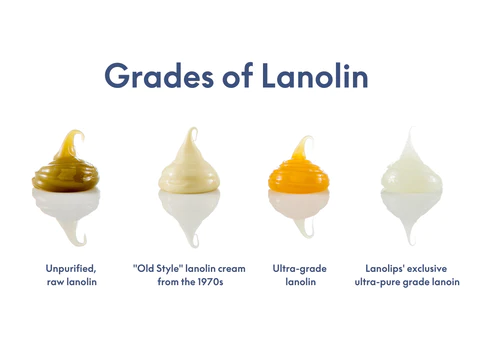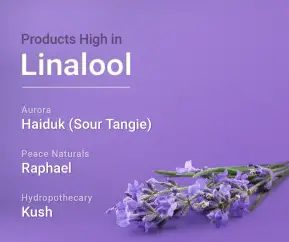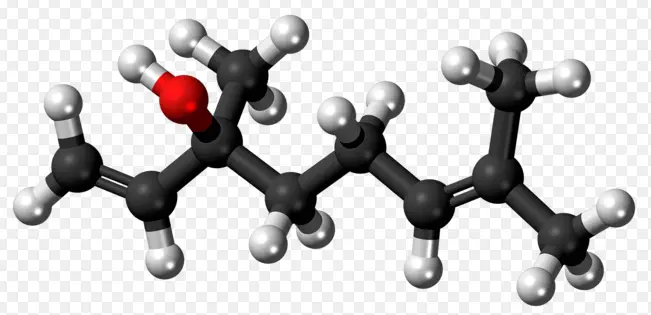Lanolin and linalool, though sounding somewhat similar, are distinct substances each with unique applications and properties. Lanolin, often hailed as a miracle moisturizer, is a natural product derived from sheep’s wool. On the other hand, linalool is known for its presence in essential oils and offers a sweet aroma, commonly utilized in the fragrance industry and in aromatherapy.
Lanolin is a waxy substance used primarily in skin care products to help retain moisture and protect the skin. Linalool, a terpene alcohol found in over 200 species of plants, is celebrated for its natural fragrance and therapeutic properties, making it a staple in perfumes and essential oils.
Both lanolin and linalool play critical roles in their respective domains but differ significantly in source, chemical nature, and usage. Lanolin is extracted from wool grease—a byproduct of wool processing—while linalool is primarily distilled from plants like lavender and coriander. These differences underline the diverse applications and benefits of each, from enhancing skin barrier function to providing soothing aromatic benefits.

What is Lanolin?
Definition and Source
Lanolin is a yellowish, waxy substance produced by the sebaceous glands of sheep. Its primary role in nature is to waterproof and protect the wool and skin of the sheep from harsh environmental conditions. Commercially, lanolin is harvested during the wool washing process, after shearing the sheep’s wool.
Chemical Properties
Lanolin is chemically akin to wax esters, and its complex composition makes it uniquely beneficial for various uses. It is predominantly made up of long-chain waxy esters, hydroxy esters, diesters, and acids. This complex mixture gives lanolin its remarkable emollient properties, which help to lock moisture into the skin.
Uses in Products
Lanolin is extensively used in cosmetic and pharmaceutical products. Its ability to act as an emollient makes it a popular ingredient in:
- Moisturizers
- Lip balms
- Baby skin products
It is also used in industrial applications such as lubricants, rust-preventive coatings, and more.
What is Linalool?
Definition and Source
Linalool is a naturally occurring terpene alcohol found in many flowers and spice plants. With over 200 species of plants producing linalool, it is especially prevalent in lavender, mint, cinnamon, and citrus fruits. This compound is highly regarded for its pleasant floral odor, making it a favored component in the fragrance industry.
Chemical Properties
Linalool is characterized by its ability to form acetate esters that contribute to its sweet, floral aroma. It exists in two enantiomeric forms, each providing slightly different odor nuances. Linalool is also known for its volatile nature, contributing to its widespread use in perfumery and aromatherapy.
Uses in Products
Due to its appealing scent and soothing properties, linalool is commonly found in:
- Perfumes and colognes
- Scented soaps
- Candles
- Aromatherapy products
It is also used as a chemical intermediate in the synthesis of vitamin E and other important compounds.
Production Process
How Lanolin is Extracted
The extraction of lanolin is a detailed process involving several steps:
- Shearing: Wool is sheared from the sheep.
- Scouring: The raw wool is washed in hot water with a special detergent to remove impurities.
- Centrifuging: After washing, the wool grease is extracted by centrifugation.
- Purification: The crude lanolin undergoes further refining to remove free wool alcohols and other impurities.
How Linalool is Distilled
Linalool is primarily extracted through the steam distillation of plant materials:
- Harvesting: Plants known for their linalool content are harvested at the peak of their aromatic potency.
- Steam Distillation: The plant material is subjected to steam, which vaporizes the volatile compound.
- Condensation: The vapor is cooled and condensed back into a liquid form.
- Separation: Linalool is separated and collected from the distillation mixture.
Key Benefits
Benefits of Lanolin in Skin Care
Lanolin offers several benefits for skin care:
- Moisture Retention: Its emollient properties help to keep the skin hydrated by forming an oily layer on the skin’s surface, trapping water beneath it.
- Healing: Lanolin is known to promote the healing of cracked skin, especially on hands and feet.
- Protection: It provides a barrier against environmental factors that can cause skin dryness and irritation.
Benefits of Linalool in Aromatherapy
Linalool is highly valued in aromatherapy for its potential therapeutic benefits, including:
- Stress Reduction: Its calming aroma can help reduce stress and anxiety levels.
- Sleep Aid: Linalool is often used in sleep aid products as its soothing properties can help improve sleep quality.
- Anti-inflammatory Properties: It has been studied for its potential to reduce inflammation, providing comfort in various conditions.

Health and Safety
Safety Profiles of Lanolin
Lanolin is widely regarded as safe for most users, especially in the concentrations used in cosmetic and pharmaceutical products. However, its safety depends largely on the purity of the product. Highly purified lanolin poses minimal risk of allergic reactions, whereas less refined versions may contain impurities that can cause skin irritation or allergies. Key points include:
- Purity Levels: Higher purity reduces the risk of skin sensitivities.
- Allergic Reactions: Some individuals may develop contact dermatitis from impurities found in lower grades of lanolin.
Safety Profiles of Linalool
Linalool, found naturally in many essential oils, is generally recognized as safe by various international health agencies. Still, like many naturally occurring substances, it can be an allergen, especially when oxidized upon exposure to air. Considerations for linalool include:
- Oxidation: Exposure to air can transform linalool into allergenic compounds.
- Usage in Cosmetics: Typically used at low concentrations to minimize potential risks.
Allergic Reactions and Sensitivities
Both lanolin and linalool can trigger allergic reactions, though these are relatively rare. Key considerations are:
- Patch Testing: Recommended for products containing these ingredients to rule out sensitivities.
- Label Warnings: Products often highlight these ingredients to inform consumers prone to allergies.
Environmental Impact
Ecological Effects of Sourcing Lanolin
The sourcing of lanolin has minimal ecological impact compared to fossil-fuel-derived ingredients. The primary concern involves the sustainable management of sheep farming:
- Sustainable Farming Practices: Ensures that wool harvesting does not negatively impact sheep welfare.
- Environmental Regulations: Adherence to regulations that protect local wildlife and habitats.
Ecological Effects of Sourcing Linalool
The cultivation of plants rich in linalool, such as lavender, must be managed responsibly to prevent:
- Overharvesting: Sustainable farming techniques are crucial to prevent depletion of plant resources.
- Land Use: Responsible agricultural practices help maintain biodiversity and soil health.
Market Trends
Demand and Supply Dynamics for Lanolin
The demand for lanolin has been consistent, driven by its widespread use in skincare and pharmaceuticals. Factors affecting its market include:
- Skin Care Popularity: Increased awareness of natural products boosts lanolin use.
- Pharmaceutical Applications: Reliable demand from the medical sector for skin treatment products.
Demand and Supply Dynamics for Linalool
Linalool’s market is influenced by its popularity in perfumery and aromatherapy. Trends impacting linalool include:
- Natural Product Preference: Rising consumer preference for natural ingredients in beauty and health products.
- Synthetic Alternatives: Availability of synthetic linalool affects natural linalool’s market dynamics.
Future Industry Predictions
Predictions for both lanolin and linalool industries point towards growth driven by natural product trends. Innovations in extraction and processing might further enhance market growth.
Consumer Insights
Preferences and Perceptions
Consumers increasingly prefer products labeled as natural or organic, which benefits the lanolin and linalool markets. Consumer beliefs often associate these compounds with health and environmental benefits.
Buying Behaviors Related to Lanolin and Linalool
Buying behavior trends show:
- Informed Choices: Consumers research ingredients before purchase, especially for skin care and aromatherapy.
- Label Transparency: Clear labeling of lanolin and linalool content is crucial for allergic or sensitive consumers.
Regulatory Landscape
Regulations Affecting Lanolin Use
Regulations for lanolin focus on ensuring product safety and purity. These regulations help prevent the presence of harmful contaminants and ensure safe concentrations in consumer products.
Regulations Affecting Linalool Use
Linalool, particularly when used in fragrances, must comply with international standards for volatile organic compounds. These regulations are designed to safeguard consumer health and ensure responsible use in products.
Frequently Asked Questions
What is Lanolin?
Lanolin is a natural, waxy substance extracted from sheep’s wool. It is highly valued in cosmetic formulations for its ability to deeply moisturize the skin, making it softer and more pliable. This makes lanolin a preferred ingredient in many lotions, creams, and lip balms.
What is Linalool?
Linalool is a naturally occurring compound found in many aromatic plant oils such as lavender and coriander. It is widely used in the perfume industry and in making essential oils due to its pleasant floral scent which is calming and contributes to stress relief.
How are Lanolin and Linalool Different?
While lanolin is derived from animal wool, linalool is sourced from plants. Lanolin acts mainly as an emollient in skincare, whereas linalool is used for its scent and potential therapeutic properties in aromatherapy and cosmetic products.
Can Lanolin or Linalool Cause Allergies?
Both lanolin and linalool have been known to cause allergic reactions in some individuals. Lanolin might trigger skin allergies particularly in those sensitive to wool, while linalool, despite being natural, can sometimes irritate the skin when included in fragrances.
Conclusion
Understanding the distinct nature and applications of lanolin and linalool is essential for making informed choices in product use, whether for personal care or aromatherapy. Each offers unique benefits tailored to different needs—from the profound moisturizing effects of lanolin to the soothing, aromatic qualities of linalool.
In summary, while lanolin and linalool may serve different purposes, both are invaluable in their respective fields. Knowing their origins, benefits, and potential allergenic effects can help consumers and professionals alike choose products that best suit their needs and preferences.

